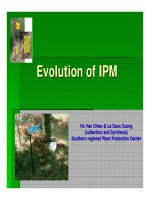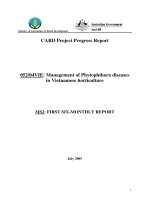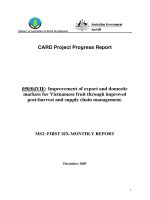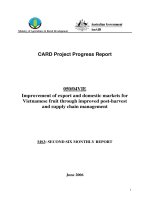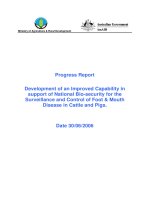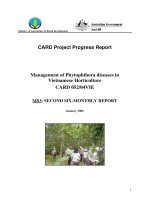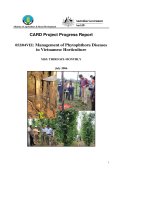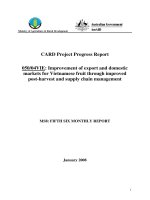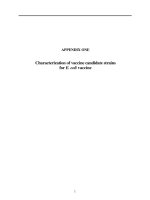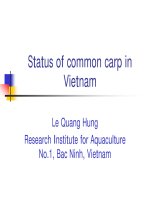Báo cáo nghiên cứu khoa học " Development of Modeling System to Simulate Hydrodynamic and Environmental Quantities in the Hai Phong Estuary, Vietnam " pot
Bạn đang xem bản rút gọn của tài liệu. Xem và tải ngay bản đầy đủ của tài liệu tại đây (324.85 KB, 8 trang )
Development of Modeling System to Simulate Hydrodynamic and
Environmental Quantities in the Hai Phong Estuary, Vietnam
Nguyen Kim Cuong
1,2
, Dinh Van Uu
2
, Umeyama Motohiko
1
1
Department of Civil and Environmental Engineering
Tokyo Metropolitan University
1-1 Minami-ohsawa, Hachioji, Tokyo 192-0397
JAPAN
2
College of Science
Vietnam National University, Hanoi
334 Nguyen Trai – Thanh Xuan – Hanoi
VIETNAM
Email:
Abstract: In this study, a hydrodynamic model was developed to simulate tidal currents in the Hai
Phong estuary, Vietnam. Three-dimensional thermo-dynamic primitive equations were used to
investigate current velocity, water level, and the sediment transport. A special computing procedure
was applied to the river boundaries because the tidal range in the area is approximately 4 m. We
tested the effects of each quantity against the observed data during the dry season. The deposited
and resuspended rates were confirmed by analytical shear stress solution in the wave-current
coexisting field. This study was extended to study turbidity in the Do Son beach area.
Keywords: HUS-VNU, Modelling system, Hai Phong.
1. INTRODUCTION
In a shallow estuary, estimation of near-shore currents is usually difficult because of its complex
topography, fluctuating sea level and river discharge, and variable wind or wave speed and direction.
To elucidate the nature of physical process in an estuary, scientists and engineers have developed
many numerical models involving advection, diffusion, and mixing within the water column and have
also studied the dynamic behavior near bottom boundary layer (BBL). In this paper, we present some
results of a real-time three-dimensional numerical simulation of the Hai Phong estuary conducted for a
period of high river discharge during monsoon. The Hai Phong estuary is a mixed estuary on the
northeastern coast of Vietnam and is connected to the South China Sea by the Gulf of Tonkin. A major
source of fresh water discharge is the Thai Binh river, with monthly average discharges ranging from
200 m
3
/s in the dry season to 1,000 m
3
/s in the wet season. Sea-level elevation having a typical tidal
range of approximately 4 m is observed on the offshore open boundaries. Other important factors that
govern circulation in the estuary are surface wind and waves. Our model considers these quantities as
surface boundary conditions.
Knowledge of circulation patterns is important for solving suspended sediment transport and water
quality problems. In addition, knowledge of bottom stress is significant to determine bed load transport
during the process of beach erosion or deposition. Therefore, to include these processes in the
circulation model of water column, an adequate expression of BBL is required. The interaction
between wave and current near the bed plays an important role and affects sediment transport and
bed formation. By using an eco-hydrodynamic model, which links coastal circulation, surface forcing,
bottom boundary layer, and environmental or suspended sediment transport models, we computed the
transport of sediment materials in response to wind, including storms, and tides over a medium time
scale.
The purpose of the study is (i) to simulate the circulation in the Hai Phong estuary, and to understand
the effects of transient winds, fluctuating tidal ranges, and river discharges on flow fields; (ii) to
calculate sediment transport relative to substantial forces; and (iii) to determine variation mechanism
of sediment concentration during a tidal cycle and study the effects of external forces on erosion or
depression in the estuary and turbidity in the Do Son beach area.
10
th
Hydraulics Conference
33
rd
Hydrology & Water Resources Symposium
34
th
IAHR World Congress
-
Balance and Uncertainty 26 June
-
1 July 2011, Brisbane, Australia
ISBN 978-0-85825-868-6 Engineers Australia3255
2. COASTAL SEA MODELLING SYSTEM
The Hanoi University of Science-Vietnam National University (HUS-VNU) modeling system, a three-
dimensional (3D) hydrodynamic ocean system (Dinh et al., 2006, 2007), was applied to study the Gulf
of Tonkin. This model solves for free surface, three components of velocity, temperature, salinity, and
turbulent kinetic energy, which are factors used to compute the vertical diffusion coefficient through
the classical k-l model. The HUS-VNU standard model, developed by GeoHydrodynamics and
Environmental Research (GHER) or University of Liege, is a 3D hydrostatic primitive equation (PE)
model that uses an Arakawa C-grid in the horizontal axis and sigma-coordinate in the vertical axis.
Further details of the GHER model can be found in studies conducted by Beckers (1991) and Barth et
al. (2007). The HUS-VNU system consists of four individual models: (i) classical 3D PE model, (ii)
surface forcing model, (iii) BBL model, and (iv) sediment transport model. The boundary conditions
can be easily described using river discharge, tidal fluctuations, wind stress, and wave force. In
addition, the Smagorinsky scheme was used to parameterize horizontal subgrid processes.
In the 3D PE model, the horizontal viscosity was computed using the following equation that considers
a Prandtl frequency M as
3,2,1,with
x
u
x
u
lMl
LLL
=
⎪
⎭
⎪
⎬
⎫
⎪
⎩
⎪
⎨
⎧
∂
∂
∂
∂
==
∑∑
βαν
αβ
α
β
β
α
, (1)
where
L
l = length scale parameter; L = 1 for
x
-axis and 2 for y -axis. For the surface forcing model,
we formularized the wind–wave interaction to obtain surface wave parameters and wind surface stress
under variable wind speed and direction. The wind surface stress can be written as
2
*a
2
10aD
uuC
ρρτ
== , (2)
where
τ
= wind surface stress,
D
C = drag coefficient,
a
ρ
= density of air,
10
u = horizontal wind speed
at 10 m from the mean sea level, and
*
u = shear velocity. The drag coefficient
D
C can be expressed
as
)cua(10C
10
3
D
+=
−
, (3)
where
10.170.0 << a
, and
12.001.0 << c
(Dinh, 1981). By parameterizing the effect of waves on the
airflow, Janssen (1991) found that the airflow stress over surface gravity waves is given by
⎟
⎟
⎠
⎞
⎜
⎜
⎝
⎛
−+
=
∗
e
0e
z
z
zzz
ln
u
u
κ
, (4)
where
z
u = horizontal wind speed at
z
,
κ
= von Karman coefficient,
e
z = surface elevation, and
0
z =
roughness length. In the BBL model, we calculated the bottom shear stress analytically using current
velocity at the point near the bottom layer. The total skin friction velocity in the current and wave
coexisting field is given by
2/12
w*
2
c*cw*
]uu[u += , (5)
where
c
u
*
= current friction velocity and
w
u
*
= wave friction velocity. These friction velocities are
defined as
2/1
*
)/(
ρτ
cc
u = and
2/1
*
)/(
ρτ
ww
u = , where
c
τ
and
w
τ
are current and wave surface
stress, respectively. According to Grant and Madsen (1979) and WAMDI group (1988), these stresses
are expressed as
2
ccc
Cu
τρ
= and
2
2
1
www
uf
ρτ
= in which
)]z/z[ln(
)]k/z30[ln(
C
0
2
2
bc
2
c
κκ
== , (6)
3256
where
bc
k = apparent bottom roughness caused by turbulence in the wave boundary layer. At each
river mouth, instead of water discharge, the total water level was added as
g2
v
2
t
≈+=
ξς
δδςς
, (7)
where
ς
= total water level at a river mouth,
t
ς
= tidal level,
ς
δ
= water level due to river discharge,
and
v = average velocity at the river mouth. The 3D sediment transport model, the model for
suspended transport of sediments, is expressed using Fick’s diffusion equation as
2
2
z
2
2
y
2
2
xs
z
c
y
c
x
c
)cw(
z
)cw(
z
)cv(
y
)cu(
xt
c
∂
∂
+
∂
∂
+
∂
∂
=
∂
∂
+
∂
∂
+
∂
∂
+
∂
∂
+
∂
∂
λλλ
, (8)
where
c = sediment concentration,
s
w
= fall velocity, and
x
λ
,
y
λ
, and
z
λ
= diffusion coefficients.
Various formulae have been developed in a two-dimensional steady-state condition on the basis of
this equation. When deposition and resuspension processes are considered at the bottom layer, the
boundary condition becomes
DEQ
z
c
cw
bottom
zs
+==
⎥
⎦
⎤
⎢
⎣
⎡
∂
∂
−
λ
, (9)
where
Q = source term describing the quantity of sediment per unit area, E = resuspension source,
and
D
= deposition source at the bottom. These source terms depend on the total skin friction shear
velocity
cw
u
*
, sinking velocity
s
w
, critical shear stress of resuspension
ce
u
*
, and critical shear stress
of deposition
cd
u
*
. In the formula, the material concentration at a reference height
a
z was assumed by
a power–law profile as
∗
−
⎟
⎟
⎠
⎞
⎜
⎜
⎝
⎛
=
u/w
a
az
s
z
z
CC
κ
, (10)
where
z
C
= material concentration, and
a
c
= reference concentration.
The bed load transport rate
b
q depends on the critical velocity characterized by the sediment type and
the total skin friction velocity determined by the flow feature. In this model, the method of Van Rijn
(1984) was used to compute the bed load transport.
3. APPLICATION OF THE NUMERICAL SYSTEM
The HUS-VNU modeling system has been used to simulate offshore water circulations in the South
China Sea and the Gulf of Tonkin. In this study, we applied the system to the near-shore flow in the
Hai Phong estuary, where the water creates a shallow and topographically complex strong tidal
system. Hai Phong is an active economic area in north Vietnam and is a principle port of the country,
contributing to its high commercial growth. The French colony built the Bach Dang estuary into a trade
base from 1876 to 1890, and since then, the Hai Phong port has handled the country’s highest cargo
volume. The complex geography was formed by sand from tributaries of the Thai Binh river. The bay
consists of numerous small rocky islands. The Bach Dang and Cam rivers flow from the mouth of the
Nam Trieu river into the sea, while the Lach Tray river flows from its own mouth. The water of Chanh
river flows into the sea through the Lach Huyen channel. Seawater flows directly into the Hai Phong
port during flood tide, and the mixed water returns to the bay during an ebb tide. After closure of the
Cam river mouth in 1981 by the Dinh Vu dyke, the Lach Huyen and Nam Trieu channels have become
3257
major routes to access Hai Phong port. The tidal range in the Gulf of Tonkin is approximately 4 m,
which greatly affects salt water intrusion. The management of the Hai Phong port is vital to the
economic success of Vietnam. But the erosion and deposition from sediment transport have
remarkably increased in recent years, creating shallower channels; the maximum depth was 11–4 m
from 1934 to 1938, 10–13 m from 1960 to 1964, and 6–12 m in 1996. These channels are dredged
annually to provide safe navigation in the waterway (Nguyen, 1999). The wind erosion in Cat Hai
Island and northern Do Son beach area is a serious issue during the southwest monsoon season from
May to August, as is turbid water in the Do Son beach area (Dinh
et al. 2008). The quality of water is
also of urgent concern because the beach is a natural heritage of the French colonial era.
Understanding the hydrodynamic aspects in the area is crucial to discovering a solution to the
deteriorating environment.
Figure 1 The research area near the Hai Phong estuary in Vietnam.
We have performed the following numerical experiments to investigate sediment problems in the Hai
Phong estuary. The near-shore circulation was simulated under wind, tide, and water discharge
variables. The sediment transport rate was then calculated relative to the substantial forces, and the
time of sediment concentration was recorded over a tidal cycle. Finally, we attempted to understand
the erosion and depression mechanism on the sea bottom and to interpret turbidity in the Do Son
beach area. The HUS-VNU modeling system provided five layers in the sigma coordinates with a
special resolution of 200 m. The model was run for 15 days to cover the dry season in which wind
speed is negligible. Figure 2 shows two instances of near-surface velocity vector plots at flood and
ebb tides. The most notable example is found in the comparison of two different tidal phases in the
western and eastern areas of the bay. During flood and ebb tides, the surface water creates
shoreward and seaward flows, respectively, in the western area but the flow is reversed in the eastern
part of the bay.
3258
Figure 2 Typical water circulation fields in the high tide (left) and low tide (right).
Figure 3 shows the distributions of surface velocity over a tidal cycle at Nam Trieu (U1) and Lach
Huyen (U2). The current turns from a northward flowing direction at flood tide to a southward flowing
direction at ebb tide in Nam Trieu, whereas the flow pattern at Lach Huyen is opposite to that of Nam
Trieu. Figure 4 shows the variations of current direction observed at Lach Huyen and Nam Trieu on
February 18 and 19, 2006. We can observe the phase difference of the current throughout the tidal
cycle from 12:00 to 19:00. The phase of the current vector in Figure 3 agrees with that of the observed
data at Lach Huyen and Nam Trieu, although they were not obtained by an entirely satisfactory
measurement process.
Figure 3 The variation of velocity vectors at the Namtrieu (U1) and Lachhuyen (U2) river
mouths.
Figure 4 The variation of measured velocity vectors at the Namtrieu and Lachhuyen river
mouths in the period of February 18-19, 2006.
3259
The seasonal effects may cause more significant damage to coasts than daily effects such as tidal
currents because the storm surge inundates low lands, erodes beaches, and increases the salinity of
rivers and estuaries in the storm or typhoon season. The extent and severity of storm impact has
recently increased as a result of regional climate change. Because a high sea level causes by a storm
of a given severity increase the flood level, the vulnerability of sea front to flooding is intensified This
study investigates a hindcasting of water level during a storm surge in the Gulf of Tonkin. The Do Son
beach area is of special interest because the coast suffered great losses from several typhoons in the
past three decades. Nevertheless, the area will remain the most important zone for resort and tourism
in north Vietnam. Figure 5 shows the water level variation for three different wind conditions: (i) U = 0
m/s, (ii) U = 5 m/s from SE, and (iii) U = 15 m/s from SE. For all cases, the water level appears nearly
sinusoidal during flood tide and has a constant value (above water) between 15:00 and 24:00 on the
first day and 40:00 and 47:00 on the second day. The southeastern wind results in wind and wave set-
up and consequently decreases the water depth during ebb tide. The difference in water level is
significant when comparing two different wind directions having same wind speed. This investigation
confirms that during storm surge, the water level rises by approximately 30 cm at Do Son beach and
20–30 cm at the Cat Hai coast.
Figure 5 Water surface variations at W (indicated in figure 1) due to some wind conditions:
tide alone (op), SE wind speed of 5 m/s, SE wind speed of 15 m/s.
The current velocity of the tide causes the onshore–offshore sediment transport, whereas waves have
an important influence on the longshore sediment transport. We determined the volumetric sediment
rate using a unit width of the vertical plane extending from the sand bottom to the water surface. We
assumed a sand bottom and several river mouths at Hai Phong Bay. We first estimated the temporal
distribution of sediment concentration at both shallow and deepwater sites near Cat Hai Island using
the sediment transport model. The concentration variation in time is illustrated in Figure 6 in which two
different plots of volumetric concentration are calculated for the tide alone and tide–wave combined
cases. The sediment concentration varies strongly as a function of time at a shallower depth because
of the tidal effect.
3260
h=3.6 m
Time (hour)
h=2.1 m
Time (hour)
Figure 6 Variation of the volumetric concentration [m
3
/m
3
] in offshore of the Cathai island
(water depth = 3.6 m) and near the Cathai island (water depth = 2.1 m) for storm wind speed of
18 m/s (serie 1) and for tide alone (serie 2).
However, the wind waves play an important role in concentration variation at the deepwater depth.
Figure 7 shows two examples of substantial wind response of sediment accumulation or erosion after
the 15-day run. Two extreme discharges are 100 m
3
/s in the dry season and 1,000 m
3
/s in the wet
season. The sediment concentrates off the mouth of Lach Huyen river represent the smallest
discharge case, but a stretch of suspended sediment is wider in the largest discharge case. Although
the amount of river discharge influences sediment transport, the ratio of the discharges at all river
mouths is the most important parameter. Note that the suspended sediment reaches Do Son in both
cases and results in high turbidity of water in the beach area. The present calculations suggest that
the high-sediment water is transported to the southeastern and eastern parts of Cat Ba Natural
Reserve Island recently polluted by high-turbidity water.
Q = 100 m
3
/s
Q = 1,000 m
3
/s
Figure 7 Simulated volumetric concentration [m
3
/m
3
] after 15 days for
the smallest discharge case [100 m
3
/s] and the largest discharge case [1,000 m
3
/s].
0
0.002
0.004
0.006
0.008
0.01
0.012
0.014
0.016
0.018
0.02
0 1020304050
Series1
Series2
0
0.002
0.004
0.006
0.008
0.01
0.012
0.014
0.016
0.018
0.02
0 1020304050
Series1
Series2
3261
4. CONCLUSIONS
By using observed values of sea levels, wind, and river discharge, we have numerically simulated the
time-dependent velocity and sediment structures in the Hai Phong estuary for several scenarios. The
results of the simulation have provided new insight into the physical processes involved in the near-
shore circulation and sediment transport. The computed velocity fields show the differences in flow
direction at two river mouths, Nam Trieu and Lach Huyen, across Cat Hai Island. This finding is
consistent with observations and is an important physical process that contributes to water
management in Hai Phong Bay. In addition to circulation produced by tidal and wind-induced currents,
the numerical study was extended to transport processes of suspended sediment in the estuary. Our
simulation result showed that sediment concentration near coasts is very high, even in the absence of
wind. The total amount of river discharge is important in changing the sediment distribution. The
substantial variation in sediment field caused by small discharge is significant at Do Son beach, where
water turbidity has recently increased.
5. REFERENCES
Barth, A., et al. (2007), Multigrid state vector for data assimilation in a two-way nested model of the
Ligurian Sea
. J. Marine Sys., 65, 41-59.
Beckers, J M. (1991),
Application of the GHER 3D general circulation model to the Western
Mediterranean
, J. Marine Sys., 1(4), 315-332.
Dinh V.U. (1981),
Wind stress on the sea surface with wave, Marine research journal, II-2, Nhatrang,
117-122 (In Vietnamese).
Dinh V.U.
et al. (2006), Development and Application of the Environmental Hydrodynamic 3D Model
for Computation and Forecasting of Oil Pollutions in Coastal Marine Environment
, Annual Report of
FY 2006 of CUP between JSPS and VAST, 191-200.
Dinh V.U.
et al. (2007), Development of system of Hydrodynamic-environmental models for coastal
area (Case study in Quang Ninh-Hai Phong region)
, Journal of Science, Earth Sciences, T. XXIII,
No.1, 59-68.
Dinh V.U. (2007),
Towards a coastal ocean monitoring and prediction system for Vietnamese Sea
Waters, The 4th Seminar on Environmental Science and Technology issues related to the Sustainable
development for urban and coastal area
, The 7th General Seminar of CUP between JSPS and VAST,
Danang, 148-153.
Dinh V.U. and Ha T.H. (2008),
Hydrodynamic modeling in tidal dominated estuarine regions, Journal
of Science, Earth Sciences, T. XXIIII, No.3, 33-38.
Dinh V.U. (2009),
Application of the sediment transport and bottom morphological change model for a
marine estuarine area of Hai Phong port
, Journal of Science, Earth Sciences, T. XXV, No.1S, 133-
139. (In Vietnamese)
Grant, W.D. and Madsen, O.S., (1979),
Combined wave and current interaction with a rough bottom,
J. Geophys. Res. 84, 1797-1808.
Jansen, P.A. (1992),
Experimental evidence of the effect of surface waves on the air flow, J. Phys.
Oceanogr. 22, 1600-1604
Nguyen D.C. (1999),
Space narrowing of tidal zone in Bach Dang estuary as a key factor causing
Haiphong port shipping channel siltation, Journal of Marine Resources and Environment
, VI, 54-69. (In
Vietnamese)
Van Rijn L.C. (1984),
Bebload transport–Part 1, Journal of Hydraulic Engineering, vol 110, No. 10,
1431-1456.
WAMDI Group. (1988),
The WAM model - the third generation ocean wave ocean wave prediction
model
, J. Phys. Oceanography, 18, 1775-1810.
3262
